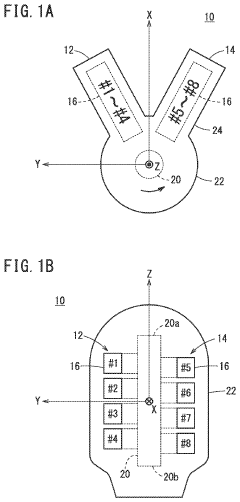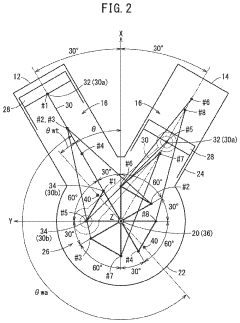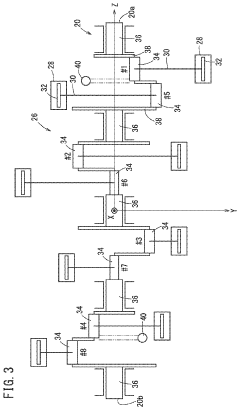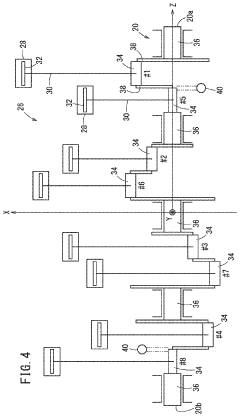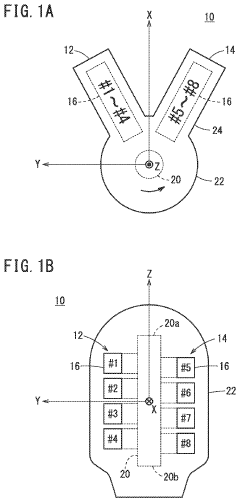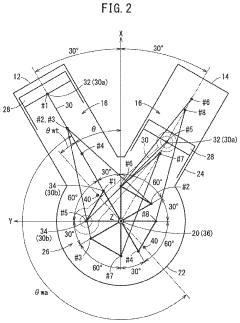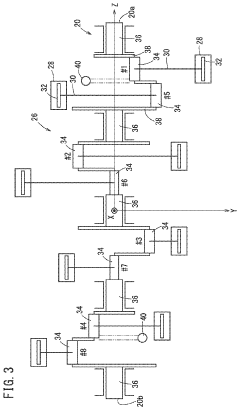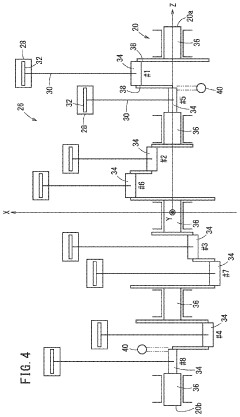V8 Engine Functionality in Harsh Environments: Explained
JUL 4, 20259 MIN READ
Generate Your Research Report Instantly with AI Agent
Patsnap Eureka helps you evaluate technical feasibility & market potential.
V8 Engine Evolution and Objectives
The V8 engine, a powerful and efficient internal combustion engine design, has undergone significant evolution since its inception. Originally developed in the early 20th century, the V8 engine has become a staple in automotive and industrial applications due to its balance of power, efficiency, and compact design. The primary objective of V8 engine development has been to maximize power output while minimizing fuel consumption and emissions.
Over the years, V8 engines have seen numerous advancements in materials, manufacturing processes, and design principles. Early V8 engines were primarily used in high-performance vehicles and luxury cars. However, as technology progressed, V8 engines found their way into a wider range of applications, including trucks, boats, and industrial machinery.
One of the key evolutionary trends in V8 engine development has been the focus on improving fuel efficiency and reducing emissions. This has led to the integration of advanced technologies such as direct fuel injection, variable valve timing, and cylinder deactivation. These innovations have allowed V8 engines to maintain their power output while significantly reducing fuel consumption and meeting increasingly stringent environmental regulations.
Another important aspect of V8 engine evolution has been the pursuit of increased durability and reliability, particularly in harsh environments. This objective has driven research into advanced materials and coatings that can withstand extreme temperatures, pressures, and corrosive conditions. The development of more robust cooling systems and improved lubrication technologies has also played a crucial role in enhancing V8 engine performance in challenging operating conditions.
The advent of electronic engine management systems has revolutionized V8 engine functionality. These sophisticated control systems allow for precise tuning of engine parameters in real-time, optimizing performance across a wide range of operating conditions. This has been particularly beneficial for V8 engines operating in harsh environments, as it enables adaptive strategies to maintain optimal performance and protect the engine from potential damage.
Looking forward, the objectives for V8 engine development in harsh environments are multifaceted. There is a continued focus on improving thermal management to enhance engine efficiency and longevity in extreme temperature conditions. Research is also being conducted on advanced materials and surface treatments that can better resist wear, corrosion, and thermal stress. Additionally, there is growing interest in developing V8 engines that can operate on alternative fuels or in hybrid configurations, further expanding their versatility in diverse and challenging environments.
Over the years, V8 engines have seen numerous advancements in materials, manufacturing processes, and design principles. Early V8 engines were primarily used in high-performance vehicles and luxury cars. However, as technology progressed, V8 engines found their way into a wider range of applications, including trucks, boats, and industrial machinery.
One of the key evolutionary trends in V8 engine development has been the focus on improving fuel efficiency and reducing emissions. This has led to the integration of advanced technologies such as direct fuel injection, variable valve timing, and cylinder deactivation. These innovations have allowed V8 engines to maintain their power output while significantly reducing fuel consumption and meeting increasingly stringent environmental regulations.
Another important aspect of V8 engine evolution has been the pursuit of increased durability and reliability, particularly in harsh environments. This objective has driven research into advanced materials and coatings that can withstand extreme temperatures, pressures, and corrosive conditions. The development of more robust cooling systems and improved lubrication technologies has also played a crucial role in enhancing V8 engine performance in challenging operating conditions.
The advent of electronic engine management systems has revolutionized V8 engine functionality. These sophisticated control systems allow for precise tuning of engine parameters in real-time, optimizing performance across a wide range of operating conditions. This has been particularly beneficial for V8 engines operating in harsh environments, as it enables adaptive strategies to maintain optimal performance and protect the engine from potential damage.
Looking forward, the objectives for V8 engine development in harsh environments are multifaceted. There is a continued focus on improving thermal management to enhance engine efficiency and longevity in extreme temperature conditions. Research is also being conducted on advanced materials and surface treatments that can better resist wear, corrosion, and thermal stress. Additionally, there is growing interest in developing V8 engines that can operate on alternative fuels or in hybrid configurations, further expanding their versatility in diverse and challenging environments.
Market Analysis for Robust V8 Engines
The market for robust V8 engines capable of operating in harsh environments has shown significant growth in recent years, driven by increasing demand from industries such as mining, construction, and heavy-duty transportation. These sectors require powerful and reliable engines that can withstand extreme temperatures, high altitudes, dusty conditions, and prolonged operation under heavy loads.
The global market for heavy-duty engines, including robust V8 engines, is expected to expand at a compound annual growth rate of 4.5% from 2021 to 2026. This growth is primarily fueled by the rising infrastructure development activities in emerging economies and the increasing adoption of advanced engine technologies in developed regions.
In the mining sector, the demand for robust V8 engines is particularly strong, as these engines are essential for powering large excavators, haul trucks, and other heavy machinery operating in challenging environments. The global mining equipment market, which heavily relies on robust engines, is projected to reach $165 billion by 2025, with a significant portion attributed to engines capable of withstanding harsh conditions.
The construction industry also presents a substantial market opportunity for robust V8 engines. As urbanization continues to accelerate worldwide, the need for powerful and durable engines in construction equipment is growing. The global construction equipment market is forecasted to exceed $200 billion by 2025, with engines being a critical component of this growth.
In the heavy-duty transportation sector, there is an increasing demand for V8 engines that can maintain performance and reliability in diverse environmental conditions. This is particularly evident in regions with extreme climates or challenging terrains, where traditional engines may struggle to operate efficiently.
The market for robust V8 engines is also being shaped by stringent emission regulations and the push for greater fuel efficiency. Manufacturers are investing in research and development to create engines that not only withstand harsh environments but also meet evolving environmental standards. This trend is driving innovation in areas such as advanced materials, improved cooling systems, and sophisticated engine management technologies.
Geographically, the Asia-Pacific region is expected to dominate the market for robust V8 engines, owing to rapid industrialization and infrastructure development in countries like China and India. North America and Europe also represent significant markets, particularly in sectors requiring high-performance engines for specialized applications.
As the demand for robust V8 engines continues to grow, manufacturers are focusing on developing engines with enhanced durability, improved power-to-weight ratios, and better fuel efficiency. These advancements are expected to further expand the market potential and open up new applications for V8 engines in harsh environments.
The global market for heavy-duty engines, including robust V8 engines, is expected to expand at a compound annual growth rate of 4.5% from 2021 to 2026. This growth is primarily fueled by the rising infrastructure development activities in emerging economies and the increasing adoption of advanced engine technologies in developed regions.
In the mining sector, the demand for robust V8 engines is particularly strong, as these engines are essential for powering large excavators, haul trucks, and other heavy machinery operating in challenging environments. The global mining equipment market, which heavily relies on robust engines, is projected to reach $165 billion by 2025, with a significant portion attributed to engines capable of withstanding harsh conditions.
The construction industry also presents a substantial market opportunity for robust V8 engines. As urbanization continues to accelerate worldwide, the need for powerful and durable engines in construction equipment is growing. The global construction equipment market is forecasted to exceed $200 billion by 2025, with engines being a critical component of this growth.
In the heavy-duty transportation sector, there is an increasing demand for V8 engines that can maintain performance and reliability in diverse environmental conditions. This is particularly evident in regions with extreme climates or challenging terrains, where traditional engines may struggle to operate efficiently.
The market for robust V8 engines is also being shaped by stringent emission regulations and the push for greater fuel efficiency. Manufacturers are investing in research and development to create engines that not only withstand harsh environments but also meet evolving environmental standards. This trend is driving innovation in areas such as advanced materials, improved cooling systems, and sophisticated engine management technologies.
Geographically, the Asia-Pacific region is expected to dominate the market for robust V8 engines, owing to rapid industrialization and infrastructure development in countries like China and India. North America and Europe also represent significant markets, particularly in sectors requiring high-performance engines for specialized applications.
As the demand for robust V8 engines continues to grow, manufacturers are focusing on developing engines with enhanced durability, improved power-to-weight ratios, and better fuel efficiency. These advancements are expected to further expand the market potential and open up new applications for V8 engines in harsh environments.
V8 Performance Challenges in Extreme Conditions
V8 engines, renowned for their power and efficiency in automotive applications, face significant challenges when operating in extreme environmental conditions. These harsh environments can include extreme temperatures, high altitudes, dusty or sandy conditions, and high humidity. Each of these factors presents unique obstacles to the optimal functioning of V8 engines.
Extreme temperatures, both hot and cold, pose substantial challenges to V8 engine performance. In extremely hot conditions, the engine may struggle with cooling efficiency, leading to potential overheating and reduced power output. Conversely, in frigid environments, cold starts become problematic, and lubricants may thicken, increasing friction and wear on engine components.
High altitude operations present another set of challenges for V8 engines. As altitude increases, air density decreases, resulting in less oxygen available for combustion. This can lead to reduced power output and decreased fuel efficiency. V8 engines may require specific tuning or forced induction systems to maintain performance at high altitudes.
Dusty or sandy environments introduce particulate matter that can infiltrate the engine, causing accelerated wear on moving parts and potentially clogging air filters. This not only reduces engine efficiency but can also lead to long-term damage if not properly addressed through robust filtration systems and regular maintenance.
High humidity environments present challenges related to corrosion and water ingestion. Moisture can accelerate the oxidation of metal components, potentially leading to premature wear or failure. Additionally, in extreme cases, water ingestion through the air intake can cause hydrolock, a severe condition that can result in catastrophic engine damage.
To address these challenges, engineers must implement various strategies and technologies. Advanced materials and coatings can be employed to improve component durability in harsh conditions. Sophisticated engine management systems can adjust parameters in real-time to optimize performance based on environmental conditions.
Improved filtration systems are crucial for protecting V8 engines in dusty or sandy environments. These may include multi-stage air filters and advanced oil filtration systems to minimize particulate ingress and extend engine life. For high-altitude operation, turbocharging or supercharging systems can help maintain power output by compensating for reduced air density.
Thermal management systems play a critical role in extreme temperature environments. Advanced cooling systems, including high-capacity radiators and oil coolers, help maintain optimal operating temperatures in hot conditions. For cold environments, technologies such as engine block heaters and advanced cold-start systems can improve performance and reduce wear during startup.
Extreme temperatures, both hot and cold, pose substantial challenges to V8 engine performance. In extremely hot conditions, the engine may struggle with cooling efficiency, leading to potential overheating and reduced power output. Conversely, in frigid environments, cold starts become problematic, and lubricants may thicken, increasing friction and wear on engine components.
High altitude operations present another set of challenges for V8 engines. As altitude increases, air density decreases, resulting in less oxygen available for combustion. This can lead to reduced power output and decreased fuel efficiency. V8 engines may require specific tuning or forced induction systems to maintain performance at high altitudes.
Dusty or sandy environments introduce particulate matter that can infiltrate the engine, causing accelerated wear on moving parts and potentially clogging air filters. This not only reduces engine efficiency but can also lead to long-term damage if not properly addressed through robust filtration systems and regular maintenance.
High humidity environments present challenges related to corrosion and water ingestion. Moisture can accelerate the oxidation of metal components, potentially leading to premature wear or failure. Additionally, in extreme cases, water ingestion through the air intake can cause hydrolock, a severe condition that can result in catastrophic engine damage.
To address these challenges, engineers must implement various strategies and technologies. Advanced materials and coatings can be employed to improve component durability in harsh conditions. Sophisticated engine management systems can adjust parameters in real-time to optimize performance based on environmental conditions.
Improved filtration systems are crucial for protecting V8 engines in dusty or sandy environments. These may include multi-stage air filters and advanced oil filtration systems to minimize particulate ingress and extend engine life. For high-altitude operation, turbocharging or supercharging systems can help maintain power output by compensating for reduced air density.
Thermal management systems play a critical role in extreme temperature environments. Advanced cooling systems, including high-capacity radiators and oil coolers, help maintain optimal operating temperatures in hot conditions. For cold environments, technologies such as engine block heaters and advanced cold-start systems can improve performance and reduce wear during startup.
Current V8 Harsh Environment Solutions
01 Cylinder Configuration and Layout
V8 engines feature eight cylinders arranged in two banks of four, forming a V-shape. This configuration allows for compact design and efficient power delivery. The V-angle between cylinder banks can vary, typically between 60 to 90 degrees, affecting engine balance and overall performance characteristics.- Cylinder Configuration and Layout: V8 engines feature eight cylinders arranged in two banks of four, forming a V-shape. This configuration allows for compact design and efficient power delivery. The V-angle between cylinder banks typically ranges from 60 to 90 degrees, influencing engine balance and vibration characteristics.
- Crankshaft and Firing Order: The V8 engine utilizes a crankshaft with specific journal arrangements to accommodate the V-configuration. The firing order is carefully designed to optimize engine balance, power delivery, and smoothness. Various firing orders are employed depending on the specific engine design and application requirements.
- Valve Train and Camshaft Systems: V8 engines employ various valve train configurations, including overhead valve (OHV) and overhead camshaft (OHC) designs. Some V8 engines feature dual overhead camshafts (DOHC) for improved performance and efficiency. Variable valve timing and lift systems are often incorporated to enhance engine performance across different operating conditions.
- Fuel Injection and Engine Management: Modern V8 engines utilize advanced fuel injection systems, including direct injection and port fuel injection technologies. Sophisticated engine management systems control fuel delivery, ignition timing, and other parameters to optimize performance, fuel efficiency, and emissions. Some V8 engines incorporate cylinder deactivation technology to improve fuel economy under light load conditions.
- Performance Enhancement and Tuning: V8 engines are often modified for increased performance through various methods. These include turbocharging, supercharging, and the use of high-performance camshafts and intake systems. Engine tuning techniques involve optimizing air-fuel ratios, ignition timing, and valve timing to extract maximum power and torque from the V8 configuration.
02 Crankshaft and Firing Order
The V8 engine utilizes a crankshaft with specific journal arrangements to accommodate the V-configuration. The firing order is carefully designed to optimize engine balance, power delivery, and smoothness of operation. Various firing orders can be employed depending on the specific engine design and application requirements.Expand Specific Solutions03 Valve Train and Camshaft Systems
V8 engines can employ various valve train configurations, including overhead valve (OHV) and overhead camshaft (OHC) designs. The camshaft system controls valve timing and lift, which significantly impacts engine performance, efficiency, and emissions. Advanced systems may include variable valve timing or lift mechanisms for optimized operation across different engine speeds.Expand Specific Solutions04 Fuel Injection and Ignition Systems
Modern V8 engines utilize sophisticated fuel injection systems, such as direct injection or port fuel injection, to precisely control fuel delivery. The ignition system is designed to provide optimal spark timing for each cylinder, often employing individual coil-on-plug arrangements. These systems work together to enhance combustion efficiency, power output, and emissions control.Expand Specific Solutions05 Performance Enhancements and Modifications
V8 engines can be modified for increased performance through various means, including turbocharging, supercharging, or the use of high-performance camshafts and intake systems. Engine management systems can be tuned to optimize power output and efficiency. Additionally, lightweight materials and advanced manufacturing techniques may be employed to reduce engine weight and improve overall vehicle performance.Expand Specific Solutions
Major V8 Engine Manufacturers and Competitors
The V8 engine functionality in harsh environments presents a competitive landscape characterized by mature technology in a well-established market. Major players like Honda, Toyota, Ford, and GM dominate with extensive R&D capabilities and global reach. The market size is substantial, driven by demand in automotive, construction, and industrial sectors. Technological advancements focus on improving efficiency, durability, and environmental performance. Emerging companies like Tula Technology and HyTech Power are introducing innovative solutions, while established manufacturers such as Cummins and Caterpillar continue to refine their offerings for harsh conditions.
Toyota Motor Corp.
Technical Solution: Toyota has developed advanced V8 engine technologies to enhance functionality in harsh environments. Their V8 engines feature a robust cooling system with improved radiator efficiency and enhanced coolant flow, allowing for optimal performance in extreme temperatures[1]. Toyota has also implemented advanced materials such as heat-resistant alloys for critical components, improving durability in high-temperature conditions[2]. Additionally, their V8 engines incorporate sophisticated electronic control units (ECUs) that continuously monitor and adjust engine parameters based on environmental conditions, ensuring consistent performance across various terrains and climates[3].
Strengths: Excellent thermal management, durability in extreme conditions, and adaptive performance. Weaknesses: Potentially higher production costs due to advanced materials and complex electronic systems.
Ford Global Technologies LLC
Technical Solution: Ford's V8 engine technology for harsh environments focuses on durability and adaptability. They have developed a high-strength aluminum alloy block that reduces weight while maintaining structural integrity in extreme conditions[4]. Ford's V8 engines also feature advanced oil cooling systems, including oil-to-water heat exchangers, which help maintain optimal oil temperature in high-stress situations[5]. The company has implemented a variable displacement system in some V8 models, allowing the engine to operate on fewer cylinders when full power is not needed, improving fuel efficiency and reducing wear in challenging environments[6].
Strengths: Lightweight yet durable construction, efficient thermal management, and adaptable performance. Weaknesses: Complexity of variable displacement system may increase maintenance requirements.
Key Innovations in V8 Durability
V8 engine
PatentActiveUS11821359B2
Innovation
- The V8 engine configuration features crank pins arranged at 90° intervals on one bank and offset by 60° on the other bank, allowing for cancellation of primary inertia couples without additional specialized parts by optimizing the arrangement of crank pins and connecting rods.
V8 engine
PatentActiveUS20230109196A1
Innovation
- The V8 engine configuration features crank pins arranged at 90° intervals on one bank and offset by 60° on the other bank, allowing for cancellation of primary inertia couples without additional specialized components by optimizing the arrangement of crank pins and connecting rods.
Environmental Regulations Impact on V8 Design
Environmental regulations have significantly impacted the design and development of V8 engines, particularly in harsh environments. These regulations, aimed at reducing emissions and improving fuel efficiency, have forced manufacturers to adapt their V8 designs to meet increasingly stringent standards while maintaining performance in challenging conditions.
One of the primary challenges faced by V8 engines in harsh environments is the need to comply with emissions regulations while operating in extreme temperatures, altitudes, or dusty conditions. To address this, manufacturers have implemented advanced fuel injection systems and engine management technologies. These systems allow for precise control of fuel delivery and combustion timing, optimizing performance and emissions across a wide range of environmental conditions.
Thermal management has become a critical aspect of V8 design in response to environmental regulations. In harsh environments, engines must maintain optimal operating temperatures to ensure efficient combustion and minimize emissions. This has led to the development of sophisticated cooling systems, including advanced radiators, oil coolers, and intelligent thermal management controls. These systems help maintain consistent engine performance and emissions compliance in extreme heat or cold.
The use of lightweight materials has also been driven by environmental regulations. Manufacturers have increasingly turned to aluminum alloys and composite materials to reduce engine weight, improving fuel efficiency and reducing emissions. These materials must be carefully selected and engineered to withstand the rigors of harsh environments, including resistance to corrosion, thermal cycling, and mechanical stress.
Exhaust aftertreatment systems have become more complex and effective in response to tightening emissions standards. Modern V8 engines often incorporate catalytic converters, particulate filters, and selective catalytic reduction (SCR) systems to reduce harmful emissions. These systems must be designed to function reliably in harsh conditions, including high temperatures, vibration, and exposure to contaminants.
The integration of advanced sensors and control systems has been crucial in meeting environmental regulations while maintaining V8 performance in harsh environments. These systems continuously monitor engine parameters, ambient conditions, and emissions levels, adjusting engine operation in real-time to optimize performance and compliance. This level of control allows V8 engines to adapt to changing environmental conditions while minimizing their ecological impact.
As environmental regulations continue to evolve, the design of V8 engines for harsh environments will likely see further innovations. This may include the development of hybrid V8 systems, incorporating electric motors to improve efficiency and reduce emissions during specific operating conditions. Additionally, research into alternative fuels and advanced combustion technologies may lead to new V8 designs that can meet future environmental standards while thriving in challenging environments.
One of the primary challenges faced by V8 engines in harsh environments is the need to comply with emissions regulations while operating in extreme temperatures, altitudes, or dusty conditions. To address this, manufacturers have implemented advanced fuel injection systems and engine management technologies. These systems allow for precise control of fuel delivery and combustion timing, optimizing performance and emissions across a wide range of environmental conditions.
Thermal management has become a critical aspect of V8 design in response to environmental regulations. In harsh environments, engines must maintain optimal operating temperatures to ensure efficient combustion and minimize emissions. This has led to the development of sophisticated cooling systems, including advanced radiators, oil coolers, and intelligent thermal management controls. These systems help maintain consistent engine performance and emissions compliance in extreme heat or cold.
The use of lightweight materials has also been driven by environmental regulations. Manufacturers have increasingly turned to aluminum alloys and composite materials to reduce engine weight, improving fuel efficiency and reducing emissions. These materials must be carefully selected and engineered to withstand the rigors of harsh environments, including resistance to corrosion, thermal cycling, and mechanical stress.
Exhaust aftertreatment systems have become more complex and effective in response to tightening emissions standards. Modern V8 engines often incorporate catalytic converters, particulate filters, and selective catalytic reduction (SCR) systems to reduce harmful emissions. These systems must be designed to function reliably in harsh conditions, including high temperatures, vibration, and exposure to contaminants.
The integration of advanced sensors and control systems has been crucial in meeting environmental regulations while maintaining V8 performance in harsh environments. These systems continuously monitor engine parameters, ambient conditions, and emissions levels, adjusting engine operation in real-time to optimize performance and compliance. This level of control allows V8 engines to adapt to changing environmental conditions while minimizing their ecological impact.
As environmental regulations continue to evolve, the design of V8 engines for harsh environments will likely see further innovations. This may include the development of hybrid V8 systems, incorporating electric motors to improve efficiency and reduce emissions during specific operating conditions. Additionally, research into alternative fuels and advanced combustion technologies may lead to new V8 designs that can meet future environmental standards while thriving in challenging environments.
V8 Engine Materials Science Advancements
The advancements in materials science have played a crucial role in enhancing the functionality of V8 engines in harsh environments. Over the years, researchers and engineers have developed innovative materials and coatings that significantly improve engine performance, durability, and efficiency under extreme conditions.
One of the key areas of focus has been the development of high-temperature resistant alloys. These advanced materials, such as nickel-based superalloys and titanium aluminides, have revolutionized the construction of critical engine components like pistons, valves, and turbocharger turbines. These alloys maintain their strength and structural integrity at temperatures exceeding 1000°C, allowing V8 engines to operate more efficiently in high-temperature environments.
Ceramic matrix composites (CMCs) have emerged as another groundbreaking material for V8 engines. These lightweight, heat-resistant materials are increasingly being used in exhaust systems and combustion chambers. CMCs offer superior thermal insulation properties, reducing heat loss and improving overall engine efficiency. Their ability to withstand extreme temperatures and corrosive environments makes them ideal for use in harsh operating conditions.
Advancements in surface engineering have led to the development of advanced coatings that protect engine components from wear, corrosion, and thermal degradation. Thermal barrier coatings (TBCs), for instance, are applied to combustion chamber surfaces and exhaust components to reduce heat transfer and protect underlying materials. These coatings, often made of yttria-stabilized zirconia, can significantly extend the lifespan of engine parts exposed to high temperatures and corrosive exhaust gases.
Nanotechnology has also made significant contributions to V8 engine materials. Nanostructured materials and coatings have been developed to enhance wear resistance, reduce friction, and improve fuel efficiency. For example, nanocomposite coatings applied to cylinder liners and piston rings can dramatically reduce wear and friction, leading to improved engine performance and longevity in harsh environments.
The integration of smart materials in V8 engines is an emerging trend that shows great promise. Shape memory alloys and piezoelectric materials are being explored for use in adaptive engine components that can respond to changing environmental conditions. These materials could potentially enable real-time adjustments to engine parameters, optimizing performance across a wide range of operating conditions.
One of the key areas of focus has been the development of high-temperature resistant alloys. These advanced materials, such as nickel-based superalloys and titanium aluminides, have revolutionized the construction of critical engine components like pistons, valves, and turbocharger turbines. These alloys maintain their strength and structural integrity at temperatures exceeding 1000°C, allowing V8 engines to operate more efficiently in high-temperature environments.
Ceramic matrix composites (CMCs) have emerged as another groundbreaking material for V8 engines. These lightweight, heat-resistant materials are increasingly being used in exhaust systems and combustion chambers. CMCs offer superior thermal insulation properties, reducing heat loss and improving overall engine efficiency. Their ability to withstand extreme temperatures and corrosive environments makes them ideal for use in harsh operating conditions.
Advancements in surface engineering have led to the development of advanced coatings that protect engine components from wear, corrosion, and thermal degradation. Thermal barrier coatings (TBCs), for instance, are applied to combustion chamber surfaces and exhaust components to reduce heat transfer and protect underlying materials. These coatings, often made of yttria-stabilized zirconia, can significantly extend the lifespan of engine parts exposed to high temperatures and corrosive exhaust gases.
Nanotechnology has also made significant contributions to V8 engine materials. Nanostructured materials and coatings have been developed to enhance wear resistance, reduce friction, and improve fuel efficiency. For example, nanocomposite coatings applied to cylinder liners and piston rings can dramatically reduce wear and friction, leading to improved engine performance and longevity in harsh environments.
The integration of smart materials in V8 engines is an emerging trend that shows great promise. Shape memory alloys and piezoelectric materials are being explored for use in adaptive engine components that can respond to changing environmental conditions. These materials could potentially enable real-time adjustments to engine parameters, optimizing performance across a wide range of operating conditions.
Unlock deeper insights with Patsnap Eureka Quick Research — get a full tech report to explore trends and direct your research. Try now!
Generate Your Research Report Instantly with AI Agent
Supercharge your innovation with Patsnap Eureka AI Agent Platform!
